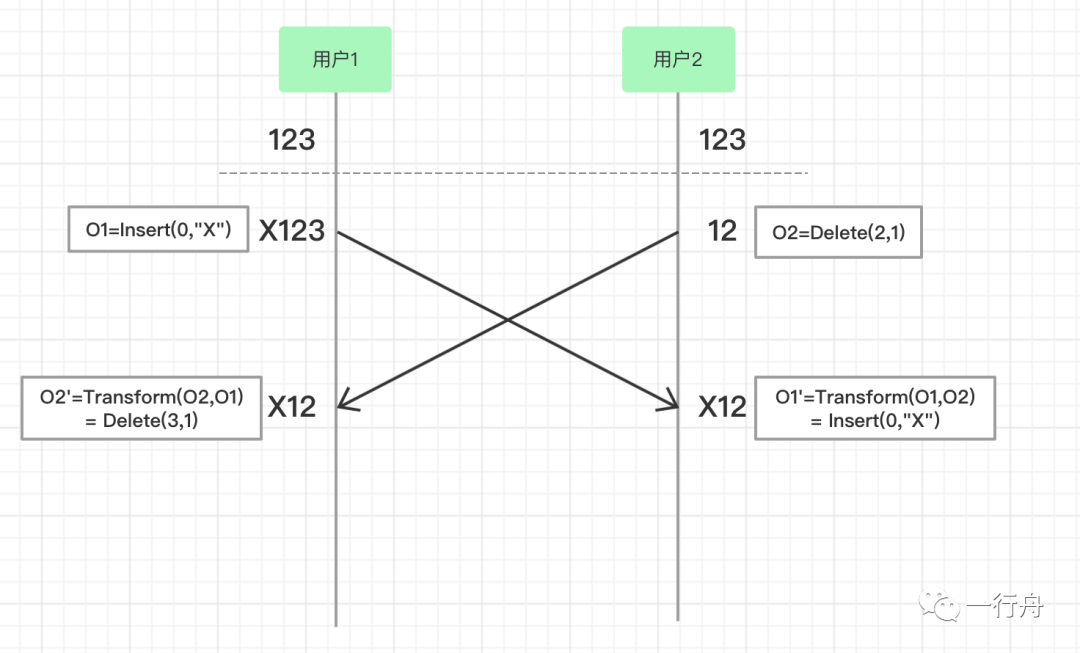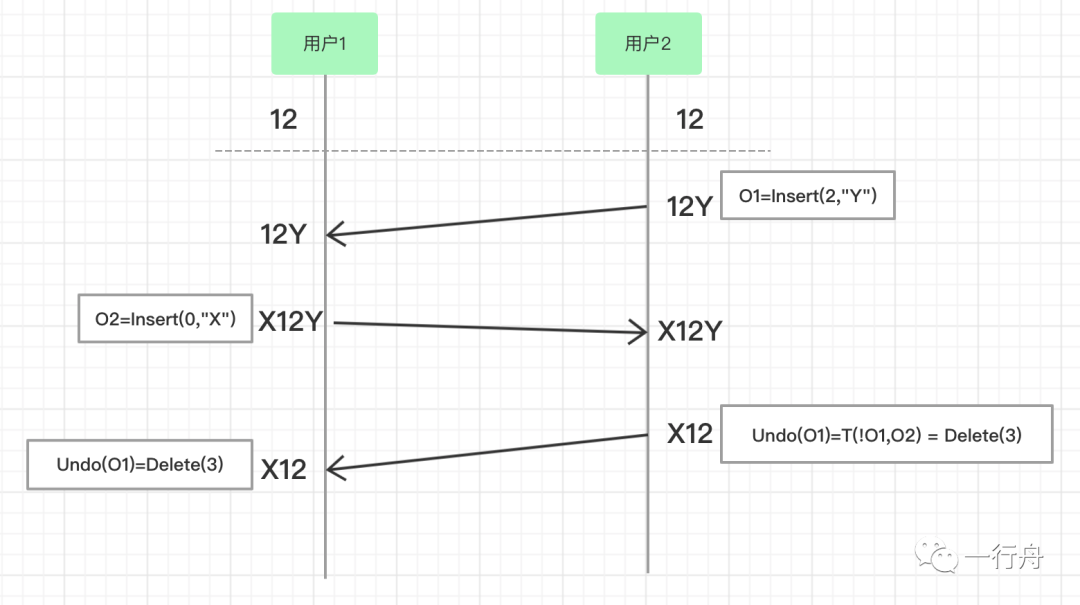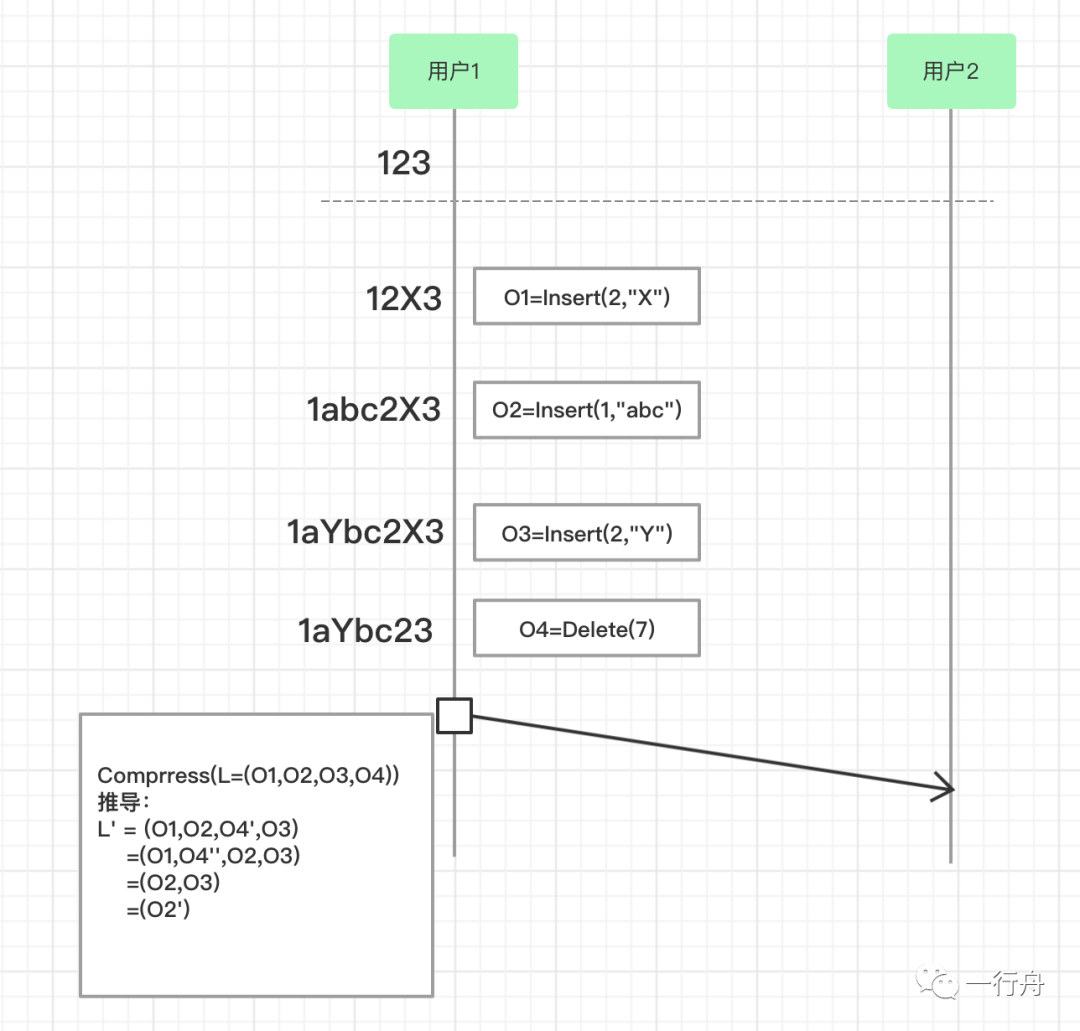OT算法
本文我们主要介绍在线文档系统中的OT算法,它用来合并多个人同时对文档的操作。文章主要分四部分:什么是OT算法、为什么多人编辑需要OT算法、文档OT算法的重要思想、文档OT算法的实战案例。
什么是OT算法
OT算法的全称是Operation Transformation,是在线协作系统中经常使用的操作合并算法。一开始它只是用来解决在线文档多人操作的合并问题,后来随着它理论知识的完善应用到了更多领域,不过在线文档仍然是典型的场景之一,Google Doc、腾讯文档、石墨文档等产品也都使用OT算法解决在线文档操作合并的问题。
OT算法是一种操作合并指导思想,是一类算法,在不同的应用场景下有不同实现。
为什么多人编辑需要OT算法
我们假设小贾和小王同时编辑一个文档。文档的初始内容是“123”,这时小贾先在123后面添加一个4,小王后在123后面添加一个5。如果没有合并算法,小贾本地文档的内容变化过程是:
- 小贾把“123”改成了“1234”。
- 接收到消息,小王在3后面加了一个5。
- 小贾本地的字符串变成了“12354”。
小王本地文档的内容变化过程是:
- 小王把“123”改成了“1235”。
- 接收到消息,小贾在3后面加了一个4。
- 小王本地的字符串变成了“12345”。
此时,小王看到的字符串是正确的,小贾看到的字符串是错误的。所以我们需要一种合并算法,保证小贾和小王看到的最终结果都正确。当更多人同时编辑文档时,需要所有人的本地操作结果都是正确的,OT算法刚好适用于解决此问题。
文档OT算法的重要思想
以下三个示例参考:https://www3.ntu.edu.sg/scse/staff/czsun/projects/otfaq/
保持内容一致性的基本思想

- 用户1和用户2同时操作,用户1的操作是
O1=Insert(0,"X"),表示在位置0,插入字符串X;用户2的操作是O2=Delete(2,1),表示从第二个位置开始删除元素,删除长度是1。 - 用户1浏览器中字符串先变成“X123”,O2操作到达用户1的浏览器之后,和O1发生转换
O2'=Transform(O2,O1)= Delete(3,1),O2'虽然也是执行删除操作,但是因为O1已经插入了X字符串,所以删除的位置+1,O2'变成了删除起始位置为3的元素,删除长度是1。对“X123”执行O2'操作,用户1本地的字符串变成“X12”。 - 用户2浏览器中字符串先变成“12”,O1操作到达用户2的浏览器之后,和O2发生转换
O1'=Transform(O1,O2)=Insert(0,"X"),因为O2删除的元素是从第二个位置开始的,对O1'添加元素没有影响,所以O1'=O1。对“12”执行O1'操作,用户2本地的字符串变成“X12”。
总之,OT通过转换方法产生一个新的操作,使当前字符串应用到转换算法之后两个浏览器的内容保持一致。
撤销操作的基本思想

- 用户2执行操作
O1=Insert(2,"Y"),在位置2插入字符串Y,用户2本地的字符串变成了“12Y”。 - 用户2的操作到达用户1的浏览器,此时用户1没有做任何操作,所以O1原样执行,用户1浏览器的字符串也变成了“12Y”。
- 用户1执行操作
O2=Insert(0,"X"),在位置0插入字符串“X”,用户1本地的字符串变成了“X12Y”。 - 用户1的操作到达用户2的浏览器,此时用户2没有其他操作,所以O2原样执行,用户2浏览器的字符串变成了“X12Y”。
- 随后用户2执行撤销操作,此时撤销操作表示为
Undo(O1)=T(!O1,O2) = Delete(3)。!O1是O1的逆向操作,本来应该是Delete(2),因为O2在字符串中增加了一个字符,所以此时的撤销操作是Delete(3),删除位置是3的元素,所以用户2本地的字符串变成了“X12”。 - 用户2的操作到达用户1的浏览器,用户1执行Delete(3)之后本地的字符串也变成了“X12”。
总之,撤销操作需要正确执行自己操作的逆向操作,还要保留其他客户端传来的执行结果。
操作压缩的基本思想

O1=Insert(2,"X")O2=Insert(1,"abc")O3=Insert(2,"Y")O4=Delete(7)
我们在传输之前,先压缩这四次操作,我们用L=(O1,O2,O3,O4)表示对4次操作的压缩。
压缩的步骤是从右往左,相邻两个操作依次进行换位(transpose)。具体步骤如下:
- O4和O3换位,
transpose(O3,O4) = (O4',O3'),此时O4‘=Delete(6),O3' = O3,L'=(O1,O2,O4’,O3)。O4‘和O3’是如何计算出来的呢?因为O4是删除位置为7的元素,也就是“1aYbc2X3”中的“X”,O3是在位置2插入字符串“Y”。交换两个操作之后先进行O4'再进行O3'。为了保证结果一致,O4'需要删除位置是6的元素,因为要删除的字符串“X”在6的位置。O3是在位置2插入字符串“Y”,和O4交换执行顺序后不受影响,所以O3'=O3。 - 继续执行,O4'和O2换位操作,
transpose(O2,O4') = (O4'',O2'),为了保持结果一致,也就是O4''还是要删除“Y”字符串,此时O4''=Delete(3),O2'还是在位置1开始插入字符串“abc”,语意保持不变,O2'=O2。此时L'=(O1,O4'',O2,O3)。 - 继续执行,O4''和O1比较发现,这两个操作是互斥的,O1在位置2后添加了字符串“X”,O4''又删除了此字符串,所以两个操作互相抵消,此时
L'=(O2,O3)。 - 继续执行,O2是在位置1后面添加字符串“abc”,O3是在位置2后面添加字符串“Y”,两个插入操作可以合并为在位置1后面添加“aYbc”,可以用
O2'=Insert(1,"aYbc")表示,L'=(O2')。 - 最终合并完的操作就变成了O2'。数据传输时,把O2'直接发送给用户2就等价于发送O1,O2,O3,O4四步操作。
总之,数据合并的基本思想就是从右向左,通过操作的两两换位(transpose),寻找到可以合并或淘汰的操作,达到compose的目的。
以上是以文档为例,说明OT算法中三个重要思想,更多OT算法的设计思路大家可以参照:https://www3.ntu.edu.sg/scse/staff/czsun/projects/otfaq/#transformation_function
文档OT算法的实战案例
我们分析一个文档OT算法的例子,源码地址:https://github.com/Operational-Transformation/ot.js 我们把用户对文档的操作分为三类:
reatin保持不变insert插入字符串delete删除字符串
操作对象:TextOperation
function TextOperation () {
if (!this || this.constructor !== TextOperation) {
// => function was called without 'new'
return new TextOperation();
}
// this.ops表示具体的操作,正数表示保持不变、负数表示要删除的字符长度,字符串表示要插入的字符串。
// 举例说明一下,[10,"-3",abcd"]表示前10个字符保持不变,然后删除三个字符,然后插入“abcd”字符串。
this.ops = [];
// 表示操作之前字符串的长度
this.baseLength = 0;
// 表示操作完成字符串的长度
this.targetLength = 0;
}this.ops表示具体的操作,正数表示保持不变、负数表示要删除的字符长度,字符串表示要插入的字符串。举例说明一下,[10,"-3",abcd"]表示前10个字符保持不变,然后删除三个字符,然后插入“abcd”字符串。
this.baseLength表示操作之前字符串的长度。
this.targetLength表示操作完成字符串的长度。
TextOperation的核心方法:transform。把两个同时发生的冲突操作A和B转换为A'和B'使 apply(apply(S, A), B') = apply(apply(S, B), A')
// 把两个同时发生的冲突操作A和B转换为A'和B'使 `apply(apply(S, A), B') = apply(apply(S, B), A')`
// 这是OT算法的核心
// 方法的传入参数operation1,operation2,分别表示操作A、B;
// operation1prime,operation2prime分别表示操作A'和B'。
TextOperation.transform = function (operation1, operation2) {
if (operation1.baseLength !== operation2.baseLength) {
throw new Error("Both operations have to have the same base length");
}
var operation1prime = new TextOperation();
var operation2prime = new TextOperation();
var ops1 = operation1.ops, ops2 = operation2.ops;
var i1 = 0, i2 = 0;
var op1 = ops1[i1++], op2 = ops2[i2++];
while (true) {
// 每一轮迭代保证operation1和operation2操作字符串的相同位置,这样转换操作才有意义。
if (typeof op1 === 'undefined' && typeof op2 === 'undefined') {
// end condition: both ops1 and ops2 have been processed
break;
}
// 接下来的两种情况:如果A、B中的一个或者两个都是insert操作。
// 在相应的运算中插入字符串,然后跳过插入字符串的长度。
// 比如:A是insert操作,那么A'也是insert操作,B'先 retain A插入字符串的长度;
// A、B都是insert操作时,A'就是insert操作,B'就是retain A插入字符串的长度之后再插入B字符串。
if (isInsert(op1)) {
operation1prime.insert(op1);
operation2prime.retain(op1.length);
op1 = ops1[i1++];
continue;
}
if (isInsert(op2)) {
operation1prime.retain(op2.length);
operation2prime.insert(op2);
op2 = ops2[i2++];
continue;
}
if (typeof op1 === 'undefined') {
throw new Error("Cannot compose operations: first operation is too short.");
}
if (typeof op2 === 'undefined') {
throw new Error("Cannot compose operations: first operation is too long.");
}
var minl;
if (isRetain(op1) && isRetain(op2)) {
// 如果A、B都是retain操作:
// 比较A、B的长度,合并后A'和B'都变成了长度较小的retain操作。
// 当A>B时,A'就变成了retain B的大小,A操作变成了retain(B-A),
// 等下一轮循环再和B中
// 相同位置的字符串合并操作。
// 反之B>A时,同理。
if (op1 > op2) {
minl = op2;
op1 = op1 - op2;
op2 = ops2[i2++];
} else if (op1 === op2) {
minl = op2;
op1 = ops1[i1++];
op2 = ops2[i2++];
} else {
minl = op1;
op2 = op2 - op1;
op1 = ops1[i1++];
}
operation1prime.retain(minl);
operation2prime.retain(minl);
} else if (isDelete(op1) && isDelete(op2)) {
// 如果A、B都是delete操作,我们合并时,
// 不需要记录delete(其实记也可以、不过A、B都delete的话没有必要)。
// 我们需要做的是把delete内容较少的忽略,保留住delete内容多的操作等下一次迭代,
// 和上面的retain道理相同。
if (-op1 > -op2) {
op1 = op1 - op2;
op2 = ops2[i2++];
} else if (op1 === op2) {
op1 = ops1[i1++];
op2 = ops2[i2++];
} else {
op2 = op2 - op1;
op1 = ops1[i1++];
}
} else if (isDelete(op1) && isRetain(op2)) {
// 如果A是delete,B是retain,比较A和B的绝对值大小。
// 如果delete的内容比retain多,那A'的delete就是B的值,A的delete长度变成A+B,
// 也就是删除内容的长度减小了;
// 如果删除和保持的内容一样多,那B'的delete等于A、B都可以;
// 如果delete的内容比retain少,那A'的delete就是A的值,B的retain长度变成A+B,
// 也就是保持的内容减少了。
if (-op1 > op2) {
minl = op2;
op1 = op1 + op2;
op2 = ops2[i2++];
} else if (-op1 === op2) {
minl = op2;
op1 = ops1[i1++];
op2 = ops2[i2++];
} else {
minl = -op1;
op2 = op2 + op1;
op1 = ops1[i1++];
}
operation1prime['delete'](minl);
} else if (isRetain(op1) && isDelete(op2)) {
// 如果A是retain,B是delete,同上。
if (op1 > -op2) {
minl = -op2;
op1 = op1 + op2;
op2 = ops2[i2++];
} else if (op1 === -op2) {
minl = op1;
op1 = ops1[i1++];
op2 = ops2[i2++];
} else {
minl = op1;
op2 = op2 + op1;
op1 = ops1[i1++];
}
operation2prime['delete'](minl);
} else {
throw new Error("The two operations aren't compatible");
}
}
return [operation1prime, operation2prime];
};逆操作:invert,通过执行逆操作可以恢复操作的效果,逆操作主要用来实现撤销功能。
// 计算操作的逆操作,通过执行逆操作可以恢复操作的效果,逆操作主要用来实现撤销功能。
TextOperation.prototype.invert = function (str) {
var strIndex = 0;
var inverse = new TextOperation();
var ops = this.ops;
for (var i = 0, l = ops.length; i < l; i++) {
var op = ops[i];
if (isRetain(op)) {
// retain的逆操作还是retain,
// 因为逆操作的目的是为了恢复操作效果,retain相当于没有操作所以逆操作也就保持不变就好了。
inverse.retain(op);
strIndex += op;
} else if (isInsert(op)) {
// insert的逆操作是delete
inverse['delete'](op.length);
} else { // delete op
// delete的逆操作是insert
inverse.insert(str.slice(strIndex, strIndex - op));
strIndex -= op;
}
}
return inverse;
};合并操作:compose,compose方法借鉴前面transform方法的思路应该很容易理解。
// 合并两个连续的操作为一个操作,合并后保持apply(apply(S, A), B) = apply(S, compose(A, B))成立
TextOperation.prototype.compose = function (operation2) {
var operation1 = this;
if (operation1.targetLength !== operation2.baseLength) {
throw new Error("The base length of the second operation has to be the target length of the first operation");
}
// 合并之后返回的操作
var operation = new TextOperation();
var ops1 = operation1.ops, ops2 = operation2.ops; // for fast access
var i1 = 0, i2 = 0; // current index into ops1 respectively ops2
var op1 = ops1[i1++], op2 = ops2[i2++]; // current ops
while (true) {
// 每一轮迭代保证operation1和operation2操作字符串的相同位置,这样合并操作才有意义。
// 根据op1和op2的操作类型选择如何合并。
if (typeof op1 === 'undefined' && typeof op2 === 'undefined') {
// 结束条件是ops1和ops2都已经遍历完成。
break;
}
// 以下内容可以参照transform方法理解,就不详细注释了。
if (isDelete(op1)) {
operation['delete'](op1);
op1 = ops1[i1++];
continue;
}
if (isInsert(op2)) {
operation.insert(op2);
op2 = ops2[i2++];
continue;
}
if (typeof op1 === 'undefined') {
throw new Error("Cannot compose operations: first operation is too short.");
}
if (typeof op2 === 'undefined') {
throw new Error("Cannot compose operations: first operation is too long.");
}
if (isRetain(op1) && isRetain(op2)) {
if (op1 > op2) {
operation.retain(op2);
op1 = op1 - op2;
op2 = ops2[i2++];
} else if (op1 === op2) {
operation.retain(op1);
op1 = ops1[i1++];
op2 = ops2[i2++];
} else {
operation.retain(op1);
op2 = op2 - op1;
op1 = ops1[i1++];
}
} else if (isInsert(op1) && isDelete(op2)) {
if (op1.length > -op2) {
op1 = op1.slice(-op2);
op2 = ops2[i2++];
} else if (op1.length === -op2) {
op1 = ops1[i1++];
op2 = ops2[i2++];
} else {
op2 = op2 + op1.length;
op1 = ops1[i1++];
}
} else if (isInsert(op1) && isRetain(op2)) {
if (op1.length > op2) {
operation.insert(op1.slice(0, op2));
op1 = op1.slice(op2);
op2 = ops2[i2++];
} else if (op1.length === op2) {
operation.insert(op1);
op1 = ops1[i1++];
op2 = ops2[i2++];
} else {
operation.insert(op1);
op2 = op2 - op1.length;
op1 = ops1[i1++];
}
} else if (isRetain(op1) && isDelete(op2)) {
if (op1 > -op2) {
operation['delete'](op2);
op1 = op1 + op2;
op2 = ops2[i2++];
} else if (op1 === -op2) {
operation['delete'](op2);
op1 = ops1[i1++];
op2 = ops2[i2++];
} else {
operation['delete'](op1);
op2 = op2 + op1;
op1 = ops1[i1++];
}
} else {
throw new Error(
"This shouldn't happen: op1: " +
JSON.stringify(op1) + ", op2: " +
JSON.stringify(op2)
);
}
}
return operation;
};操作转字符串:apply,此方法的作用是把操作应用到字符串中,得到新的字符串。
// 根据原始字符串和操作返回新的字符串
TextOperation.prototype.apply = function (str) {
var operation = this;
if (str.length !== operation.baseLength) {
throw new Error("The operation's base length must be equal to the string's length.");
}
var newStr = [], j = 0;
var strIndex = 0;
var ops = this.ops;
for (var i = 0, l = ops.length; i < l; i++) {
var op = ops[i];
if (isRetain(op)) {
if (strIndex + op > str.length) {
throw new Error("Operation can't retain more characters than are left in the string.");
}
// 复制老字符串中被retain的部分
newStr[j++] = str.slice(strIndex, strIndex + op);
strIndex += op;
} else if (isInsert(op)) {
// 加入insert字符串
newStr[j++] = op;
} else { // 删除操作
strIndex -= op;
}
}
if (strIndex !== str.length) {
throw new Error("The operation didn't operate on the whole string.");
}
return newStr.join('');
};难理解的代码加了比较详细的注释,大家通过阅读注释可以清楚的看懂代码逻辑。
服务端
Server代表服务端对象:
// 把当前文档存储到document,所有操作放到operations数组。
function Server (document, operations) {
this.document = document;
this.operations = operations || [];
}
// Call this method whenever you receive an operation from a client.
// 当接收到客户操作时调用此方法。
Server.prototype.receiveOperation = function (revision, operation) {
if (revision < 0 || this.operations.length < revision) {
throw new Error("operation revision not in history");
}
// Find all operations that the client didn't know of when it sent the
// operation ...
// 通过版本号找到所有当前客户端未知的操作...
var concurrentOperations = this.operations.slice(revision);
// ... and transform the operation against all these operations ...
// ...并针对所有未知操作进transform
var transform = operation.constructor.transform;
for (var i = 0; i < concurrentOperations.length; i++) {
operation = transform(operation, concurrentOperations[i])[0];
}
// ... and apply that on the document.
// ...并把操作应用到文档。
this.document = operation.apply(this.document);
// Store operation in history.
// 记录用户的操作。
this.operations.push(operation);
// It's the caller's responsibility to send the operation to all connected
// clients and an acknowledgement to the creator.
// 返回操作,并由调用此方法的地方把operation广播给其他用户。
return operation;
};客户端
Client代表客户端对象:
function Client (revision) {
this.revision = revision; // 下一个预期的版本号
this.state = synchronized_; // 当前状态
}客户端有Synchronized、AwaitingConfirm、AwaitingWithBuffer三种状态:
// Synchronized状态代表客户端没有需要发送到服务端的操作。
function Synchronized () {}
Client.Synchronized = Synchronized;
...省略Synchronize绑定的方法。
// AwaitingConfirm状态代表客户端有一个操作已经发送给服务端,等待服务端响应。
function AwaitingConfirm (outstanding) {
// 记录已经发送等待返回的操作
this.outstanding = outstanding;
}
Client.AwaitingConfirm = AwaitingConfirm;
...省略AwaitingConfirm绑定的方法。
// AwaitingWithBuffer状态代表客户端有一个操作已经发送给服务端,等待服务端响应,并且本地有更多操作还在等待发送
function AwaitingWithBuffer (outstanding, buffer) {
// 记录已经发送等待返回的操作
this.outstanding = outstanding;
// 记录客户端未发送的操作
this.buffer = buffer;
}
Client.AwaitingWithBuffer = AwaitingWithBuffer;
...省略AwaitingWithBuffer绑定的方法。三种状态对应各自的操作方法。
Synchronized:
Synchronized.prototype.applyClient = function (client, operation) {
// 当用户编辑文档时把操作发送到服务端,然后切换到AwaitingConfirm状态
client.sendOperation(client.revision, operation);
return new AwaitingConfirm(operation);
};
Synchronized.prototype.applyServer = function (client, operation) {
// 从服务端接收到新的操作时,把操作应用到当前文档。
client.applyOperation(operation);
return this;
};AwaitingConfirm:
AwaitingConfirm.prototype.applyClient = function (client, operation) {
// 当用户编辑文档时并不立刻发送操作给服务端,而且把状态切换到AwaitingWithBuffer。
return new AwaitingWithBuffer(this.outstanding, operation);
};
AwaitingConfirm.prototype.applyServer = function (client, operation) {
// 服务端返回的operation和本地操作合并的菱形图表示:
//
// /\
// this.outstanding / \ operation
// / \
// \ /
// pair[1] \ / pair[0] (new outstanding)
// (can be applied \/
// to the client's
// current document)
// pair[1] 可以应用到本客户端。
var pair = operation.constructor.transform(this.outstanding, operation);
client.applyOperation(pair[1]);
return new AwaitingConfirm(pair[0]);
};
AwaitingConfirm.prototype.serverAck = function (client) {
// 服务端已确认客户端的操作然后切换到Synchronized状态。
return synchronized_;
};
AwaitingConfirm.prototype.transformSelection = function (selection) {
return selection.transform(this.outstanding);
};
AwaitingConfirm.prototype.resend = function (client) {
// The confirm didn't come because the client was disconnected.
// Now that it has reconnected, we resend the outstanding operation.
// 客户端断开重连之后,继续发送operation。
client.sendOperation(client.revision, this.outstanding);
};AwaitingWithBuffer:
AwaitingWithBuffer.prototype.applyClient = function (client, operation) {
// 合并用户操作。
var newBuffer = this.buffer.compose(operation);
return new AwaitingWithBuffer(this.outstanding, newBuffer);
};
AwaitingWithBuffer.prototype.applyServer = function (client, operation) {
// Operation comes from another client
//
// /\
// this.outstanding / \ operation
// / \
// /\ /
// this.buffer / \* / pair1[0] (new outstanding)
// / \/
// \ /
// pair2[1] \ / pair2[0] (new buffer)
// the transformed \/
// operation -- can
// be applied to the
// client's current
// document
//
// * pair1[1]
var transform = operation.constructor.transform;
var pair1 = transform(this.outstanding, operation);
var pair2 = transform(this.buffer, pair1[1]);
client.applyOperation(pair2[1]);
return new AwaitingWithBuffer(pair1[0], pair2[0]);
};
AwaitingWithBuffer.prototype.serverAck = function (client) {
// operration已经服务端确认,发送buffer操作,并把状切换为AwaitingConfirm。
client.sendOperation(client.revision, this.buffer);
return new AwaitingConfirm(this.buffer);
};
AwaitingWithBuffer.prototype.transformSelection = function (selection) {
return selection.transform(this.outstanding).transform(this.buffer);
};
AwaitingWithBuffer.prototype.resend = function (client) {
// The confirm didn't come because the client was disconnected.
// Now that it has reconnected, we resend the outstanding operation.
// 客户端断开重连之后,继续发送operation。
client.sendOperation(client.revision, this.outstanding);
};
每一种状态执行完成之后,本地的版本号会加1。
限于篇幅原因,编辑器调度部分和undo的实现就不进行源码分析了,感兴趣的同学可以直接阅读源码。源码内容分别在
edit-client.js和undo-manager.js。
依赖此仓库实现的OT操作流程单步演示:http://operational-transformation.github.io/index.html。

总结
不同的系统有不同的OT算法,如何保证OT算法的准确性是一个难题,需要不断摸索。OT算法也有自己的局限性,也无法保证合并结果完全符合用户的预期。
还有一种合并算法叫CRDT,后续再和大家分享CRDT相关的知识。
如果文中有您不认同的地方欢迎指出,希望和对OT算法、CRDT感兴趣的同学一起交流学习。
相关链接
[1]https://en.wikipedia.org/wiki/Operational_transformation [2]https://www3.ntu.edu.sg/scse/staff/czsun/projects/otfaq/ [3]https://github.com/share/sharedb [4]https://www.shangmayuan.com/a/eaa92ee4dce945f4b733a372.html [5]https://github.com/Operational-Transformation/ot.js